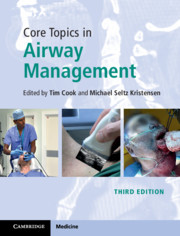Book contents
- Core Topics in Airway Management
- Core Topics in Airway Management
- Copyright page
- Contents
- Contributors
- Foreword
- Preface to the Third Edition
- Section 1 Airway Management: Background and Techniques
- Section 2 Airway Management: Clinical Settings and Subspecialties
- Chapter 22 The Airway in Obstetrics
- Chapter 23 The Paediatric Airway
- Chapter 24 Airway Management in Obesity
- Chapter 25 Maxillofacial and Dental Surgery
- Chapter 26 Ear, Nose and Throat Surgery: Airway Management
- Chapter 27 Lung Separation
- Chapter 28 Airway Management in the Critically Ill
- Chapter 29 The Patient with a Tracheostomy
- Chapter 30 Pre-hospital and Trauma Airway Management
- Chapter 31 Airway Management during CPR
- Chapter 32 The Bloody and Bleeding Airway
- Chapter 33 The Airway in Anaesthesia for Transoral Robotic Surgery
- Section 3 Airway Management: Organisation
- Index
- References
Chapter 32 - The Bloody and Bleeding Airway
from Section 2 - Airway Management: Clinical Settings and Subspecialties
Published online by Cambridge University Press: 03 October 2020
- Core Topics in Airway Management
- Core Topics in Airway Management
- Copyright page
- Contents
- Contributors
- Foreword
- Preface to the Third Edition
- Section 1 Airway Management: Background and Techniques
- Section 2 Airway Management: Clinical Settings and Subspecialties
- Chapter 22 The Airway in Obstetrics
- Chapter 23 The Paediatric Airway
- Chapter 24 Airway Management in Obesity
- Chapter 25 Maxillofacial and Dental Surgery
- Chapter 26 Ear, Nose and Throat Surgery: Airway Management
- Chapter 27 Lung Separation
- Chapter 28 Airway Management in the Critically Ill
- Chapter 29 The Patient with a Tracheostomy
- Chapter 30 Pre-hospital and Trauma Airway Management
- Chapter 31 Airway Management during CPR
- Chapter 32 The Bloody and Bleeding Airway
- Chapter 33 The Airway in Anaesthesia for Transoral Robotic Surgery
- Section 3 Airway Management: Organisation
- Index
- References
Summary
Bleeding in the upper airway is an important cause of airway-related death, even in young and otherwise healthy individuals. The estimated lifetime incidence of epistaxis is approximately 60%; post-tonsillectomy haemorrhage occurs in 6–15% of tonsillectomy cases; and bleeding following surgery for malignancy in the upper airway is one of the leading causes of requirement of an emergency front of neck airway. Pre-oxygenation may be difficult or impossible. Cornerstone techniques commonly employed to secure the airway, such as direct/videolaryngoscopy and flexible optical laryngoscopy, may be ineffective due to soiling of the hypopharynx – and the equipment – with blood. Supraglottic airway devices may be employed but are typically of limited efficacy due to the increased risk of aspiration and their potential interference with surgical access to the bleeding site in the hypopharynx, glottis and trachea. The clinician may thus be forced to use other, less familiar techniques and modify their approach to airway management, particularly if bleeding is profuse and/or conventional intubation and airway rescue techniques are predicted to be difficult. Cardiovascular compromise from blood loss may further complicate airway management and anaesthesia. We identify techniques and strategies that may be employed in this situation.
Keywords
- Type
- Chapter
- Information
- Core Topics in Airway Management , pp. 282 - 289Publisher: Cambridge University PressPrint publication year: 2020

